The Empire State Building, a towering symbol of New York City, showcases the iconic Art Deco architectural style. Standing at 1,454 feet tall (443 meters), this 102-story skyscraper was constructed in a remarkable 410 days, ahead of schedule and under budget. The building’s exterior features a limestone facade, while the interior showcases Art Deco elements like chrome, aluminum, stainless steel, and marble. It was designed by William F. Lamb of the architectural firm Shreve, Lamb, and Harmon, the Empire State Building drew inspiration from earlier structures like the Reynolds Building and the Carew Tower. Lamb, the lead architect, conceived the distinctive Art Deco crown and spire, giving the building its iconic silhouette. The building serves various purposes, acting as an iconic landmark, office space, and telecommunications facility. Its design efficiently utilizes space, and the spire and antenna mast contribute to its role as a major telecommunications node. Regular maintenance, including cleaning, HVAC system upkeep, and structural enhancements, ensures the building’s functionality and aesthetic appeal. The Empire State Building symbolizes New York City’s ambition, resilience, and economic power. Its Art Deco style reflects the modernity of the early 20th century, and the building remains deeply ingrained in American culture, frequently appearing in films, TV shows, and commercial products. In terms of safety and accessibility, the Empire State Building adheres to CDC, government, and industry guidelines. It achieved the WELL Health-Safety certification and incorporates advanced safety measures, including touchless interactions and enhanced cleaning procedures. The building is fully ADA-compliant, ensuring accessibility for visitors with disabilities. For architects and enthusiasts, an “All Access Tour” provides an in-depth exploration of the Empire State Building, covering behind-the-scenes areas, historical details, and exclusive access to observatories. Architects can draw valuable lessons from the Empire State Building’s design and construction. The key takeaways include collaboration among stakeholders, constant refinement of design, modularization, and a balance between innovation and proven techniques.
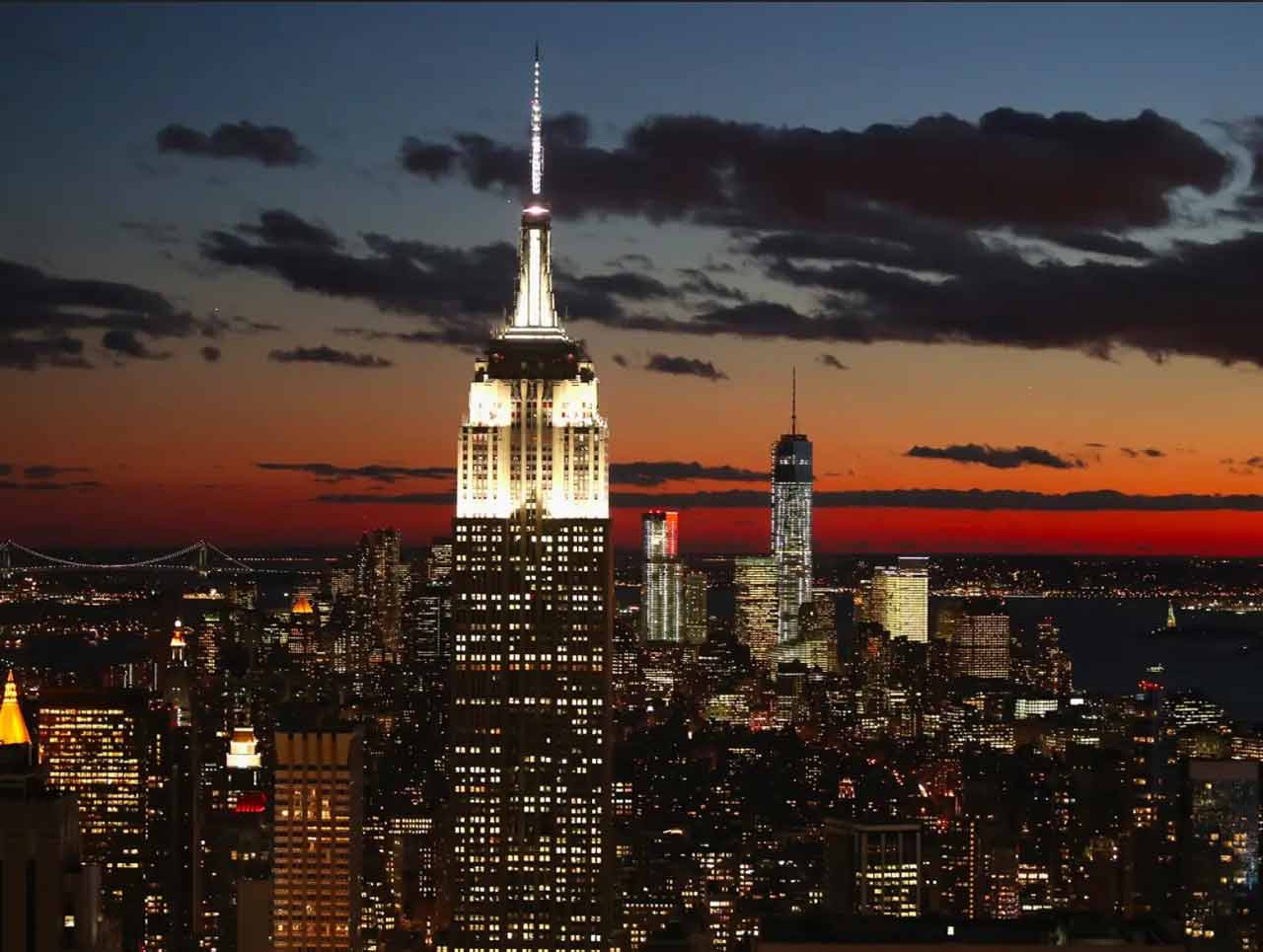
What is the Empire State Building?
The Empire State Building is an iconic 102-story Art Deco skyscraper located in Midtown Manhattan, New York City. The building is standing at 1,454 feet (443 meters) tall, it was the world’s tallest building for nearly 40 years until the construction of the original World Trade Center in 1970. The Empire State Building was built by businessman John J. Raskob and former New York Governor Al Smith in 1929 as part of an intense competition among developers to build the world’s tallest building. They hired architect William F. Lamb of Shreve, Lamb, and Harmon who designed the building in just two weeks, drawing inspiration from earlier structures like the Reynolds Building in North Carolina and the Carew Tower in Ohio. Excavation began in January 1930 and construction started on St. Patrick’s Day that year, involving over 3,000 workers. When completed in 1931, the Empire State Building soared to 1,454 feet tall (443 meters) with its Art Deco spire and 102 stories, easily surpassing the Chrysler Building to become the world’s tallest building. It also featured cutting-edge technology like 67 high-speed elevators. Although initially nicknamed the “Empty State Building” due to low occupancy rates during the Great Depression, it eventually became profitable. It became an American cultural icon, appearing in over 90 films like the original King Kong. Today, the Empire State Building remains one of New York’s most popular attractions, drawing around 4 million visitors annually to its observatories on the 86th and 102nd floors. From there, guests can take panoramic views spanning up to 80 miles on clear days. The building is also renowned for its nightly light shows, illuminating its top floors in various colors to celebrate holidays, events, and charitable causes.
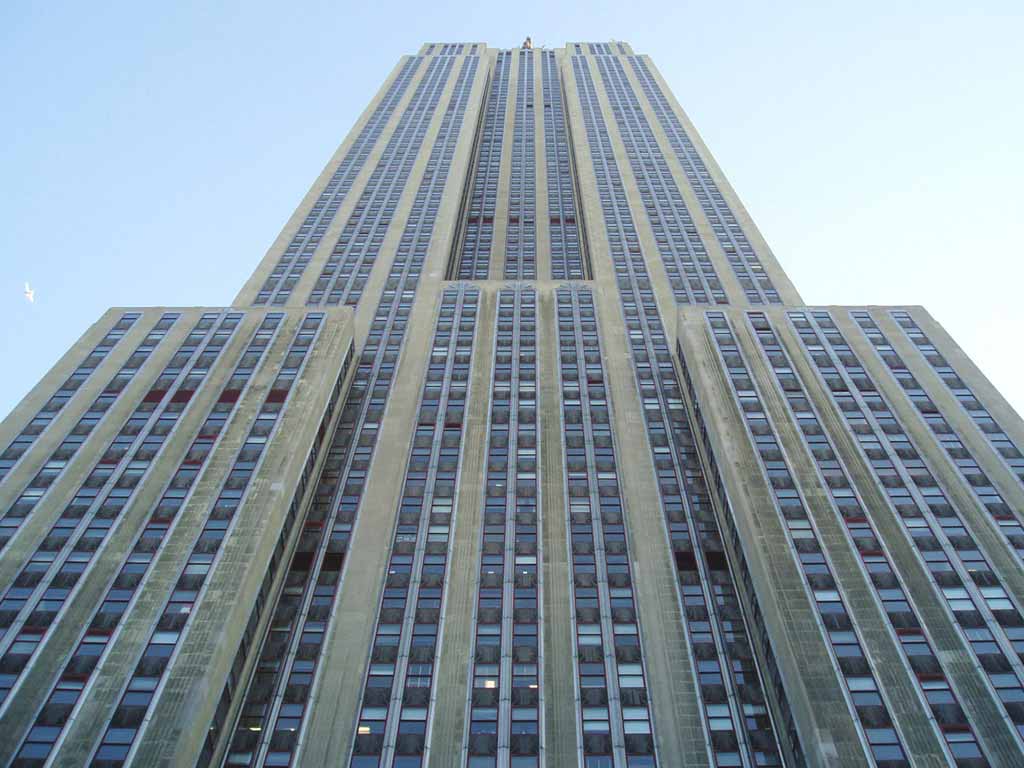
What architectural style is most prominent in the Empire State Building?
The prominent architectural style of the Empire State Building is Art Deco. This style emerged in 1920s France and soon spread worldwide, embodying themes of modernity, glamor, and technological innovation. The Empire State Building was designed by the architectural firm Shreve, Lamb, and Harmon, which embraced the Art Deco aesthetic in creating the iconic 102-story skyscraper. The building features narrow vertical windows alternating with wider windows, creating a striped effect accentuated by the vertical lines of the limestone cladding. The tower tapers in a series of dramatic setbacks as it rises, with the upper floors stepped back from the center core. The building’s crown is a defining Art Deco feature. The Empire State Building’s entrances and lobby spaces showcase more sleek Art Deco details including chrome, aluminum, stainless steel, marble, and inlaid wood paneling. Inside, visitors traverse high-ceilinged hallways lined with metal railings and geometric wall patterns leading to the Art Deco elevator banks.
What structural engineering principles are employed in the construction of the Empire State Building?
The Empire State Building employed structural engineering boundaries to new heights. Firstly, its framework consists of a steel load-bearing structure from the sub-basement to the 86th floor, with the upper floors supported by lighter steel framing. The building utilizes a stiff “tube within a tube” design. Its exterior limestone facade and interior corridor walls form a sturdy outer tube that helps resist lateral wind loads. Secondly, the closely spaced grid of steel columns maximized available rental space but required engineering solutions to allow large open areas on each floor. This allowed the building to have one of the highest rentable area-to-gross area ratios of any skyscraper built at the time. Thirdly, the Empire State’s foundation system was also innovative, using floating caissons – concrete-filled steel boxes sunk deep into bedrock through layers of dense clay. The caissons support a grillage system of crisscrossed steel beams that distribute the building’s enormous weight across the underlying schist bedrock.
Lastly, the building was designed and constructed to act as a natural lightning rod, with a network of aluminum strips integrated into its structure descending into the ground. This helps divert lightning strikes from the surrounding area and prevent damage.
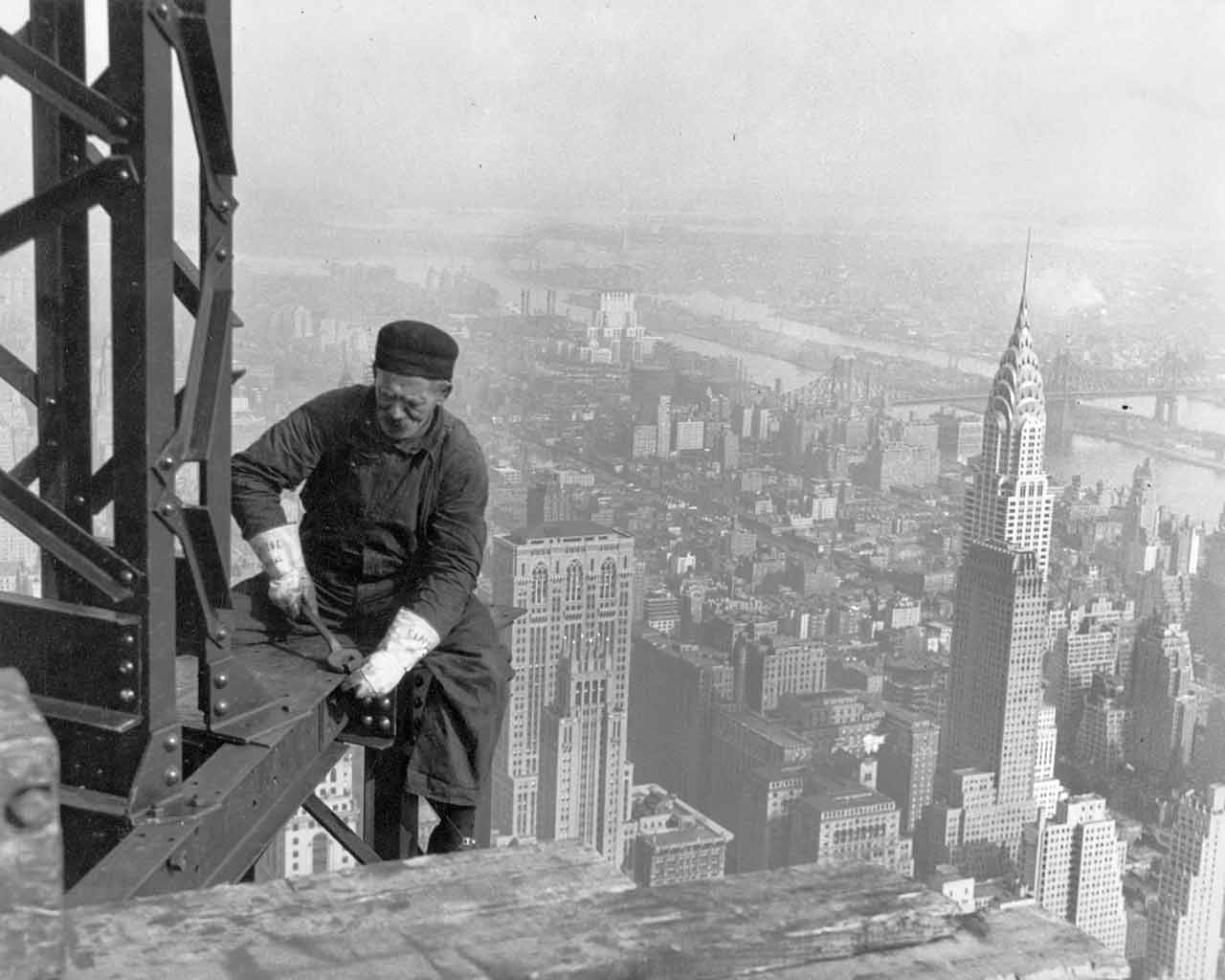
Who designed the Empire State Building?
The Empire State Building was designed by the architectural firm Shreve, Lamb, and Harmon. Specifically, William F. Lamb was the lead architect who drew up the plans for the building. Lamb worked for the firm Shreve, Lamb, and Harmon, which had previously designed the Reynolds Building in Winston-Salem, North Carolina, and the Carew Tower in Cincinnati. Lamb used these two earlier Art Deco towers as inspiration when conceiving the design for the Empire State Building in just two weeks in 1929. The building was designed from the top down, starting with the 102nd floor and working down. Lamb proposed the idea for the tower’s distinctive art deco crown, including the slender mast topped by a 204-foot spire. The crown gives the building its signature vertical thrust and iconic silhouette on the New York skyline. Although Lamb is credited as the lead designer, the entire Shreve, Lamb, and Harmon firm played a pivotal role in shaping the Empire State Building. Partner Richmond Shreve oversaw the team and made key decisions while William Harmon also helped refine Lamb’s original renderings. The firm specializes in designing skyscrapers, having already completed notable towers like the Reynolds Building and Carew Tower. Their experience with steel structures and elevators enabled them to meet the challenge of creating the world’s tallest building at the time.
What are the historical design influences visible in the Empire State Building?
The Empire State Building’s distinctive Art Deco style reflects design influences from earlier 1920s skyscrapers. Chief architect William Lamb drew inspiration from his previous work on the Reynolds Building in North Carolina and the Carew Tower in Ohio. These earlier towers feature vertical solid lines and stepped terraced profiles yet ornate geometric details that also define the Empire State Building. The Reynolds Building’s vertical striped facade, created by alternating bands of windows and brickwork, echoes the Empire State Building’s narrow vertical windows. The Carew Tower’s robust, tiered base tapering to a little central tower also resembles the Empire State Building’s shape. Beyond these two structures that directly inspired its design, the Empire State Building exhibits other key Art Deco characteristics that reflect broader architectural trends in 1920s America. Its stainless steel canopies, sleek metal railings, geometric wall patterns and motifs, and machine-age materials like aluminum and chrome all exemplify Art Deco’s embrace of modern technology and mass production. The building also contains influences from past architectural eras. The predominance of stone and brick on the lower exterior walls reflects the masonry tradition of Classical and Renaissance architecture.
How has the Empire State Building influenced the design of other buildings in New York City?
The Empire State Building set the Art Deco skyscraper design standard and influenced subsequent high-rise construction in New York City. Later skyscrapers incorporated similar vertical emphasis, symmetrical facade layouts, and setbacks. The GE Building at Rockefeller Center, finished in 1933, echoes the Empire State in its vertical solid lines, drawing the eye upwards. The Solow Building, which was completed in 1974, also clearly took inspiration from the Empire State in its vertical orientation. In addition to design, the Empire State showed that extremely tall buildings were commercially viable. It stood as the world’s tallest building for nearly 40 years and demonstrated the public’s thirst for ever-higher skyscrapers with views over the city. Buildings like the original World Trade Center towers took this to even greater heights when finished in the early 1970s. The Empire State Building provided an Art Deco template for designing a successful skyscraper. Over 90 years since its completion, it remains one of New York’s most iconic and influential structures.
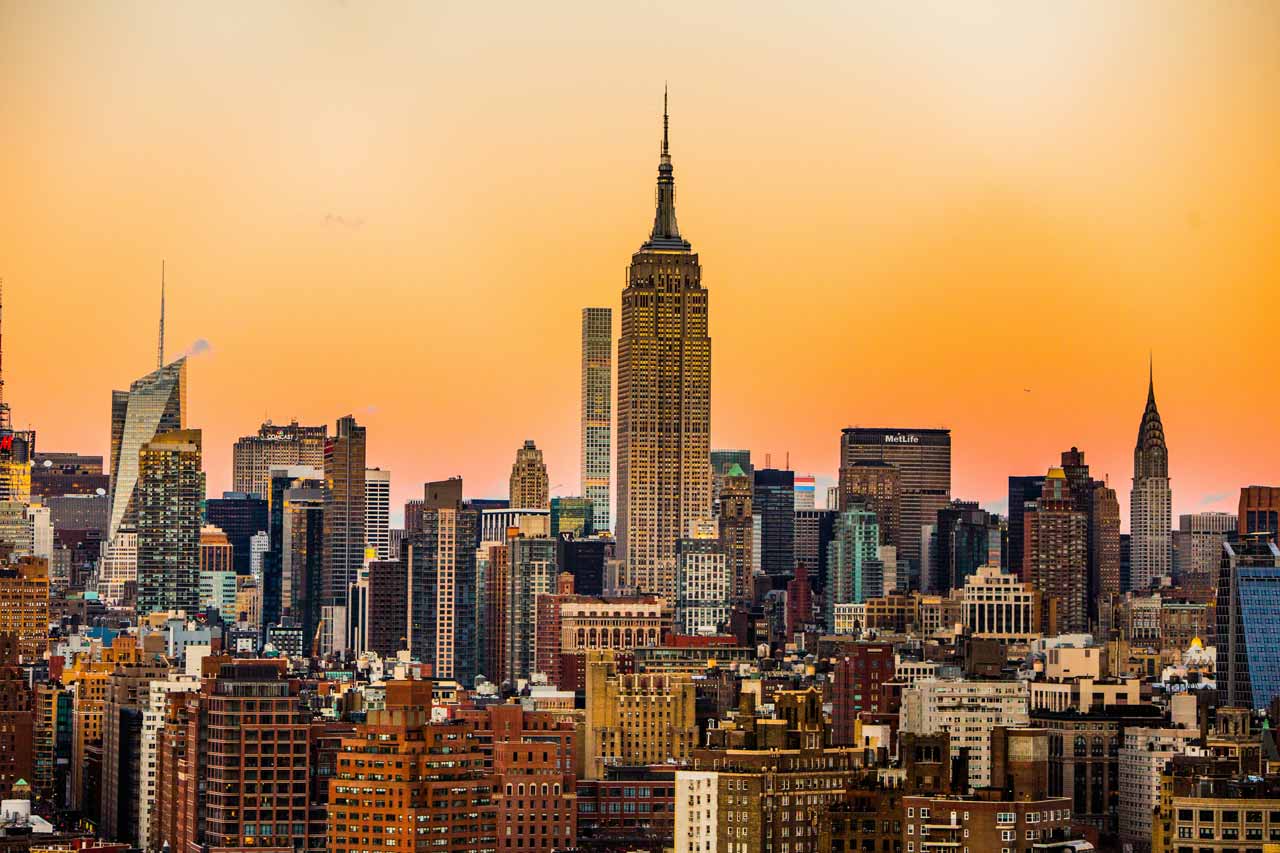
What purpose does the Empire State Building serve and how does the design help?
The Empire State Building’s purpose is multifaceted as an iconic landmark, office space, and telecommunications facility. It is one of New York City’s most iconic and recognizable landmarks, representing the city on the global stage. Its distinctive Art Deco design makes it extremely photogenic and a popular tourist destination. The building’s design is focused on efficient use of space. The spire and antenna mast on top allow it to serve as a major telecommunications node in the New York area, with both broadcasting and wireless capabilities. In terms of design, the 102-story height makes it visible from far away and a dramatic addition to the NYC skyline. This supports its status as an iconic landmark. The sleek art deco limestone and metal exterior is both aesthetically pleasing and functional, befitting an office building. The steel frame structure provides durability and strength to enable its towering height. This allows for prime views and broadcast capabilities from the higher floors and mast.
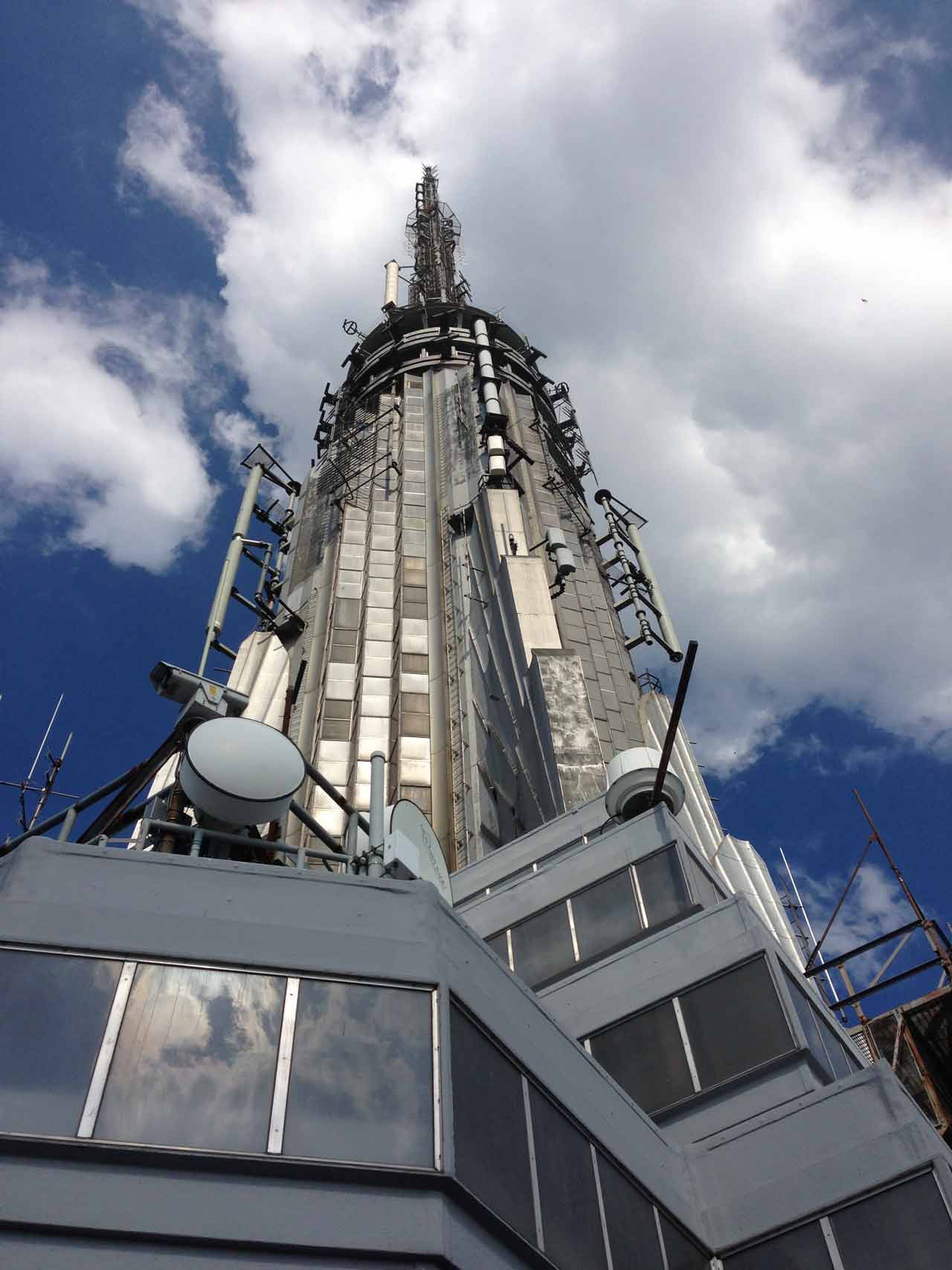
How is the Empire State Building maintained?
The Empire State Building requires regular maintenance across various aspects to keep it functioning and looking its best. Firstly, the building has an exclusive provider, Alliance Maintenance, that offers conventional and advanced janitorial services exceeding industry standards. Tenants can request customized cleaning programs to fit their budget. The building also uses “green cleaning” products for impeccable yet eco-friendly cleaning. The standard operating hours for HVAC systems are 8 am-6 pm on weekdays. Requests for temperature adjustments or issues with heating/cooling can be submitted to building management via an online portal. Special arrangements can be made for HVAC needs outside regular hours. Secondly, the building is upgrading to improve elevator speed, energy efficiency, and overall passenger experience through an ongoing partnership with Otis Elevators. Thirdly, in terms of structural maintenance, a recent $20 million (€18.53 million, £15.78 million) renovation project restored the building’s iconic Art Deco design. This included replacing all original sealant joints on the aluminum panels, repairing historic portholes, recoating the aluminum façade, and more. Rigging specialists helped remove old antennas, cables, and equipment from the spire and mast, while engineering teams repaired and waterproofed the historic cast aluminum facade. Lastly, ongoing sustainability efforts also help maintain and improve the 90-year-old building. An energy efficiency retrofit cuts energy usage by 38% and costs by $4.4 million (€4.04 million, £3.45 million) annually through upgrades like demand control ventilation, lighting, and more. The building continues to implement innovative solutions, like one of the world’s largest elevator modernization programs, to improve environmental performance.
How does the Empire State Building reflect cultural and contextual relevance in its design?
The Empire State Building symbolized New York City’s ambition, optimism, and economic power. Its record-breaking height of 102 stories (1,250 feet tall) represented the city’s drive to be the greatest in the world. Architecturally, its Art Deco style exterior echoed the modernity and technological advancements of the era, such as mass production, transportation, and communication innovations. The building features many hallmarks of Art Deco architecture, including a streamlined steel frame structure, vertical emphasis, stepped-back design, geometric ornamentation, and aluminum and stainless steel cladding. These design choices aligned with common aesthetics and materials of the time. As an innovation icon, the Empire State Building captured the essence of New York City and America’s cultural ethos in the early 20th century. It represented the country’s capitalist spirit, economic dominance, and technological capabilities. Even as the Great Depression hit, the “Empty State Building” eventually filled up and symbolized the nation’s resilience. Today, the Empire State Building remains deeply ingrained in American culture. Its image frequents films, TV shows, commercial products, and more, where it often signifies New York City itself. In declaring the skyscraper a modern Wonder of the World, the American Society of Civil Engineers recognized its technological achievements and status as a national symbol.
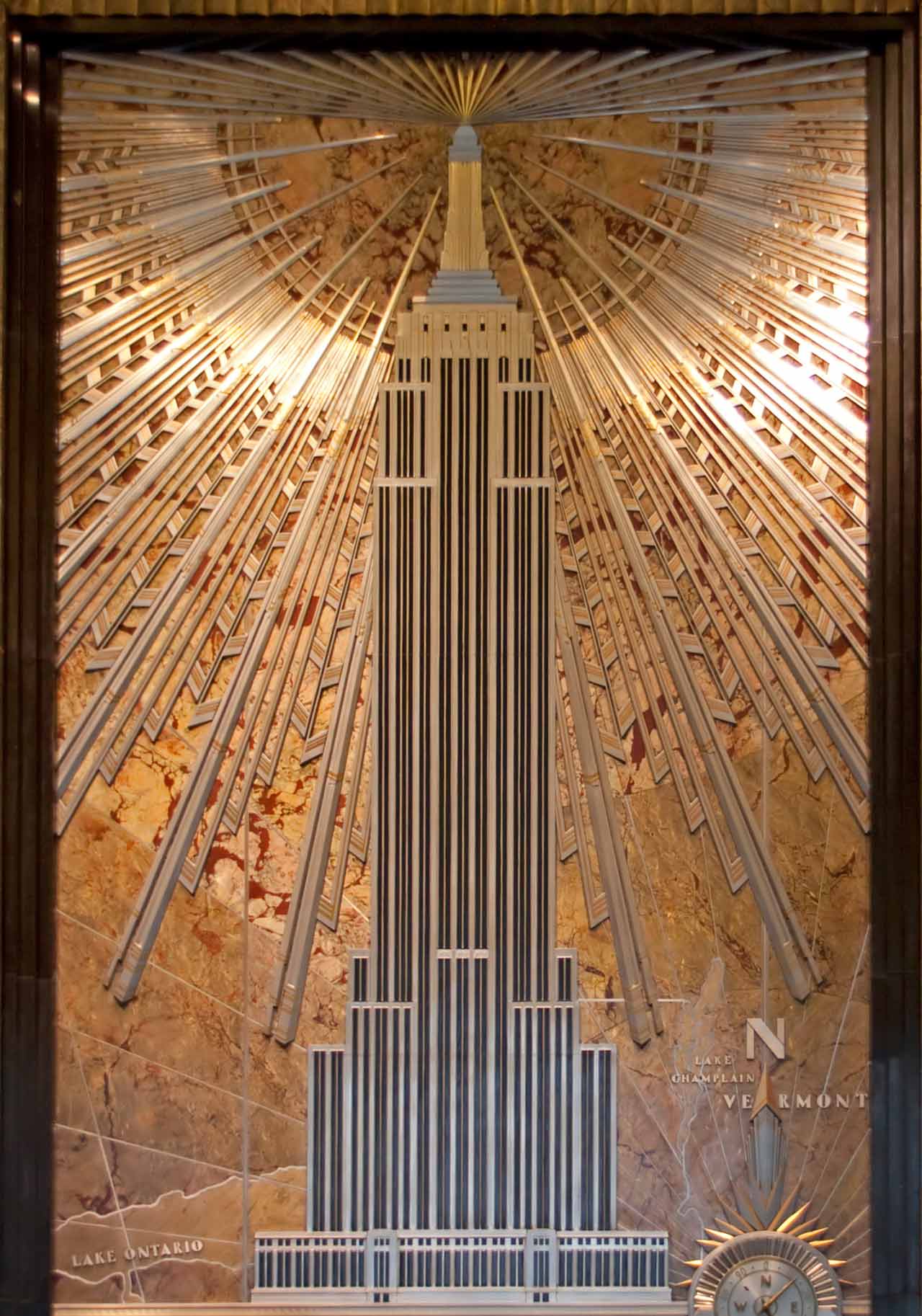
What architectural trend or movement does the Empire State Building represent?
The Empire State Building is considered a prime example of Art Deco architecture, a style that was popular in the 1920s and 1930s and emphasized modernity, sleek lines, and ornamentation using geometric shapes and exotic materials like chrome, glass, and aluminum. Key external features that exemplify the Art Deco style include the building’s setbacks, vertical lines, metal cladding, and abstract geometric patterns along the upper floors. Art Deco architecture reacted against the more ornate Beaux Arts and Neoclassical styles that preceded it by removing classical decorative elements in favor of a streamlined and futuristic look using new materials. The Empire State Building captured this modernist spirit and the technological advancements of its time such as mass production, transportation innovations, and early communications.
Its completion in 1931 also aligned with the peak of the Art Deco movement. Architect William F. Lamb studied at the Ecole des Beaux-Arts in Paris which informed his design. The influence of the school’s modernist focus combined with Lamb’s background in classical architecture training allowed him to fuse both old and new.
What are the challenges faced during the restoration of the Empire State Building?
The recent restoration of the iconic Empire State Building to its original Art Deco design involved several key challenges. Firstly, decades’ worth of clutter from telecommunications equipment that had been added to the spire and mast over the years was removed. The teams had to carefully dismantle this unorganized mass of cables, antennas, and hardware to restore the lines of the spire while preserving necessary equipment. Secondly, accessing the building’s exterior aluminum decorative panels between the 80th and 102nd floors for resurfacing. Specialized rigging crews used suspended scaffolding, industrial rope access, and outdoor elevators to conduct hands-on panel repairs in precarious positions over 1,000 feet above ground. Lastly, the building’s original stainless steel frames, cast aluminum panels, and glass blocks also needed restoration – a complex process requiring custom metalwork fabrication to match historical designs. Inside, workers faced obstacles restoring Art Deco details in the lobby that had been covered up or removed over the decades. This included recreating a gold leaf celestial mural on the ceiling without the original plans and working around foot traffic in the busy lobby. Empire State Building restoration aimed to overcome challenges and return the icon to its 1930s glory.
How does the Empire State Building comply with contemporary safety and accessibility standards?
The Empire State Building has implemented measures aligned with CDC, government, and industry guidelines to ensure visitor health and safety. This includes advanced air filtration systems that neutralize 99.92% of Coronavirus, touchless interactions, enhanced cleaning procedures using green products, and social distancing protocols.
In 2020, it became the first commercial portfolio to achieve the evidence-based WELL Health-Safety certification for cleaning, emergency preparedness, health services, air/water quality management, and communications. Infrastructure upgrades like elevators and electrical modernizations continue to incorporate the latest safety codes and technology. Safety barriers, procedures, and equipment protect workers during frequent exterior renovations. The building withstood a 1945 plane crash, demonstrating robust structural safety and stability. The Empire State Building is fully ADA-compliant with a handicap-accessible entrance, ramps lowered viewing walls, and wheelchair lending. The building’s bathrooms, exhibits, and attractions are accessible to those with disabilities. Proactive policies, training, and communications promote inclusion. Dedicated pages detail accessibility services while staff are prepared to accommodate special needs. The Empire State Building continues to evolve in terms of its safety and accessibility.
Are there any specific tours for architects or architecture enthusiasts visiting the Empire State Building?
Yes, the Empire State Building offers an “All Access Tour” ideal for architects and architecture enthusiasts. This 90-minute guided tour includes exclusive behind-the-scenes access and priority entry. The tour begins in the Celebrity Entrance corridor and green room, which features memorabilia from celebrity visitors. Highlights include the new guest-only 34th Street entrance with a 25-foot (7.62 meters) model of the building, access to the restored Art Deco lobby and its ceiling mural. The 86th-floor observatory provides 360-degree open-air views from the outdoor deck, while the enclosed 102nd-floor observatory features floor-to-ceiling windows for unmatched panoramic views. The “All Access Tour” also includes historical and architectural details that appeal to your interests.
What lessons can architects learn from the design and construction of the Empire State Building?
The Empire State Building is an icon of efficient design and construction, offering several key lessons for architects. Firstly, the building was designed through close collaboration between architects, engineers, owners, and builders, enabling rapid problem-solving and decision-making. Architects should engage with all project stakeholders from the outset to optimize workflows. Secondly, the design was constantly refined to enable the fastest possible construction, using techniques like fast-track design and an optimized construction sequence. Architects should consciously eliminate inefficiencies at every stage while still delivering quality. Thirdly, the builders leveraged repetition and modularization, treating materials like an assembly line. Architects should maximize standardized and prefabricated elements to improve constructability. Lastly, the builders balanced innovation with proven techniques. Architects should incorporate advanced methods where helpful while recognizing that traditional approaches often suffice. The Empire State Building exemplifies that even monumentally complex projects can be executed with efficiency, quality, and cost-effectiveness through an integrated effort that prioritizes optimization at every level. Its construction principles and benchmarks for speed should continue inspiring architects over 90 years later.
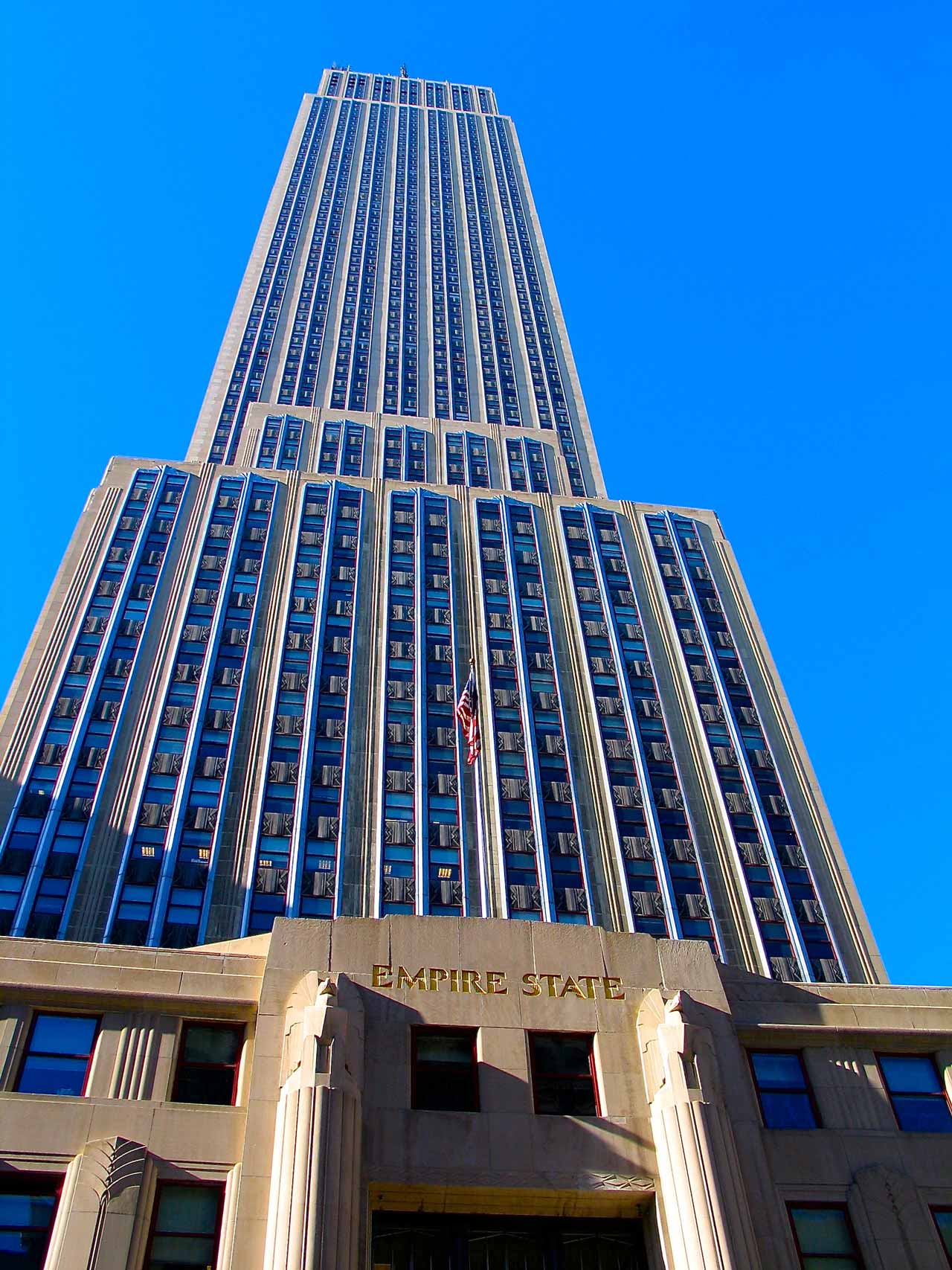
What are the best architectural landmarks in New York City to visit as an architect?
Listed below are the best architectural landmarks in New York City to visit as an architect:
- Empire State Building: The Empire State Building is a must-visit for architects interested in the evolution of high-rise construction. Designed by Shreve & Lamb and completed in 1931, this iconic structure was once the world’s tallest building. Its distinctive stepped form and steel frame construction represent significant advancements in skyscraper technology. The building’s observation decks provide a unique perspective on New York City’s urban layout, making it not just an architectural icon but also a key vantage point for understanding the city’s development.
- Guggenheim Museum: The Guggenheim Museum by Frank Lloyd Wright is a landmark destination for architects exploring organic architecture. Opened in 1959, its unique spiral structure and continuous ramp challenge traditional museum layouts, offering an uninterrupted journey through the exhibits. Wright’s design philosophy, which sought harmony between the structure and its environment, is demonstrated in the museum’s integration with its urban context. The building’s form and function make it a pivotal study in architectural innovation.
- Chrysler Building: The Chrysler Building is an architectural symbol of the Art Deco era, making it an essential visit for architects studying this design movement. Completed in 1930 and designed by William Van Alen, its distinctive stainless steel crown and spire showcase exquisite decorative artistry. The building’s interior, especially its lobby, reflects the opulence of the late 1920s and early 1930s. It stands as a testament to the era’s architectural creativity and the technological advancements in skyscraper design.
- The High Line: The High Line is an outstanding example of urban regeneration and landscape architecture, offering architects insights into innovative urban design and public space revitalization. Transformed from an elevated freight rail line into a public park by Diller Scofidio + Renfro and James Corner, it blends horticulture, art, and design within a dense urban context. This project demonstrates the potential of adaptive reuse in urban environments and the integration of green spaces within cityscapes.
- One World Trade Center: One World Trade Center is a significant architectural site for architects interested in skyscraper design and urban resilience. Completed in 2014 and designed by David Childs of Skidmore, Owings & Merrill, it stands as a symbol of rebirth on the site of the original Twin Towers. The building features advanced safety and sustainability elements, making it a modern architectural marvel. Its design respects the site’s history while marking a new era in high-rise construction.
- Flatiron Building: The Flatiron Building is an architectural icon and a pioneering skyscraper in New York City, significant for architects studying early 20th-century urban architecture. Completed in 1902 and designed by Daniel Burnham, its unique triangular shape and Renaissance Revival style were innovative for its time. The building’s slender profile and distinct facade have made it a symbol of New York’s architectural heritage, offering insights into the city’s architectural evolution.
- Brooklyn Bridge: As one of the oldest suspension bridges in the United States, the Brooklyn Bridge is a landmark of engineering and architecture. Completed in 1883 and designed by John Augustus Roebling, it connects Manhattan and Brooklyn across the East River. The bridge’s Gothic-style stone towers and intricate cable arrangement make it a study in both aesthetic beauty and structural ingenuity. For architects, it represents a significant moment in the history of bridge design and urban connectivity.
- Seagram Building: The Seagram Building, designed by Ludwig Mies van der Rohe and Philip Johnson, is a fundamental site for architects interested in modernist architecture. Completed in 1958, this skyscraper is celebrated for its functional aesthetics and adherence to the ‘less is more’ philosophy. Its use of high-quality materials, like bronze and travertine, and the concept of the elevated plaza as an urban space, have influenced subsequent office building designs. The building exemplifies the International Style and has had a lasting impact on corporate architecture.


